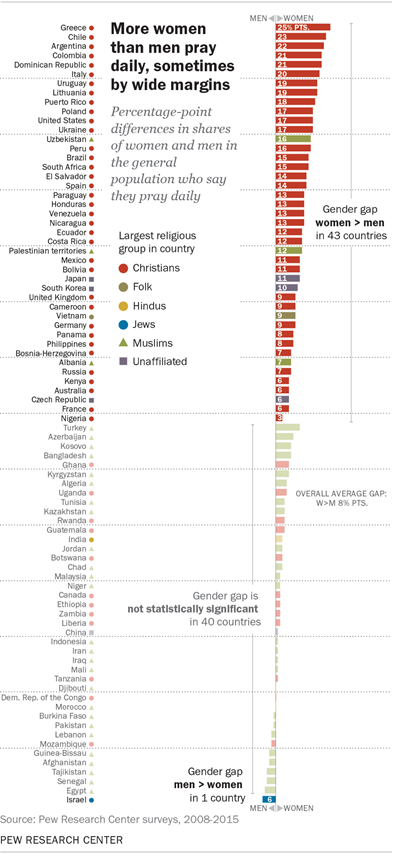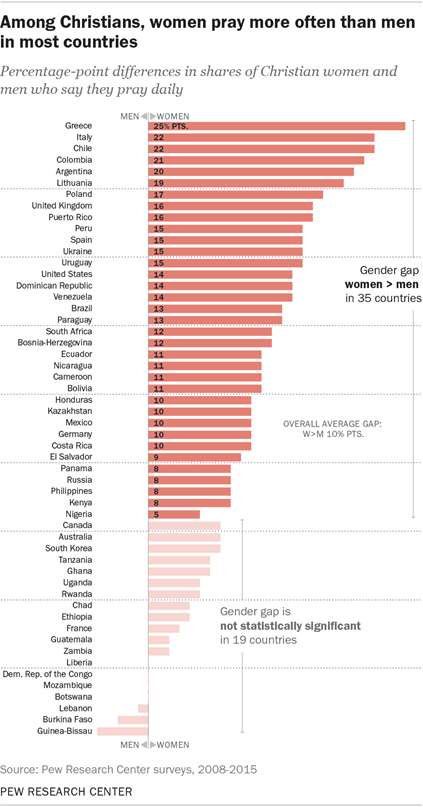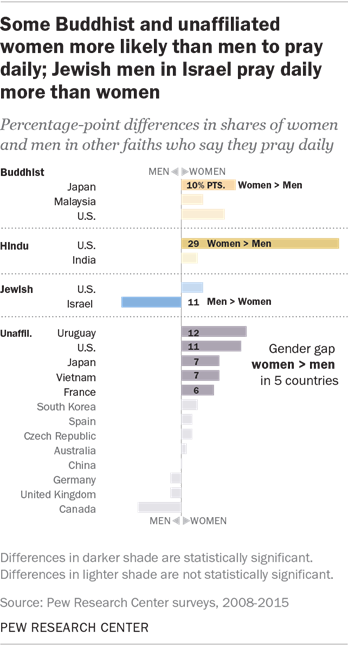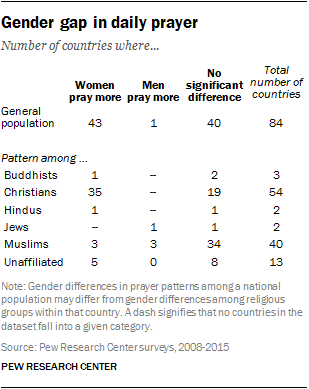Another widely accepted indicator of religious commitment is daily prayer. Pew Research Center has collected data on frequency of prayer in 84 countries. In 40 of those countries, there is no significant difference in levels of daily prayer reported by men and women.
But in 43 countries (just over 50% of the total), women report that they pray daily at greater rates than men, sometimes by margins as wide as 25 percentage points (in Greece) or 20 points (in Italy). In 29 of those 43 countries, the share of women who say they pray at least once a day exceeds the share of men who say the same by 10 percentage points or more. As a result, when all 84 countries are considered together, women surpass men in saying they pray daily by an average of 8 percentage points. This average gender gap is the largest one among all the indicators of religious commitment analyzed for this report.
Israel is the only country where men report praying daily more often than women (30% vs. 24%). This finding reflects, in part, the large population of Orthodox Jews in Israel, as does the pattern seen in weekly attendance.

Looking at the data by religious group, Christians display the largest gender difference in frequency of prayer. In nearly two-thirds of the 54 countries for which data on Christian prayer practices are available, a larger share of Christian women than Christian men report that they pray daily, often by wide margins. And across all 54 countries, 61% of Christian women report praying daily compared to 51% of Christian men, for a gender gap of 10 percentage points.

There are some major regional differences among Christians. In most countries in North and South America and in some European countries, the share of Christian women who pray daily tends to be notably larger than the share of Christian men who pray daily. But in most sub-Saharan African countries, Christian men and women report similarly high levels of daily prayer, resulting in little or no gender gap.
Muslim women are as likely as Muslim men to report engaging in daily prayer.22 This differs from the attendance pattern, in which Muslim men are significantly more likely to report attending worship services weekly. In the vast majority of countries (34 out of 40) where Muslim populations were surveyed on this topic, similar shares of Muslim men and women (71% and 72%) report praying every day. In three of the countries – Uzbekistan, Kosovo and the Palestinian territories – women pray more often than men. And in three other countries – Mozambique, Tanzania and Senegal – Muslim men are more likely than women to report engaging daily in prayer.

Classifying people by whether they do or do not say they pray at least once a day helps distinguish between more devout and less observant followers of many religions. However, this distinction may not adequately measure private devotion in Islam because for Muslims, praying five times daily, not just once a day, is a requirement, or “pillar,” of religious observance for the faithful. Mindful of this, when Muslim men and women were asked in Pew Research Center surveys about daily prayer, they had an opportunity to say how often they prayed during the day. The results indicate that whether prayer was done five times a day or once a day, the gender differences are about the same. On average, 56% of Muslim women and 57% of Muslim men say they pray five times daily, while 72% of women and 71% of men say they pray at least once a day.23
Among Hindus, daily prayer is more common among women than men by 29 percentage points in the U.S., but the gender differences among Hindus in India are not statistically significant.24 And among Buddhists, women also report a higher rate of daily prayer than men, but the difference is statistically significant only in Japan, where Buddhist women and men vary in their prayer frequency by 10 percentage points.

 Among Jews, gender differences are statistically significant in Israel but not the United States. In Israel, men are more likely than women to pray at least once a day by 11 percentage points. This pattern is evident among Orthodox Jews as well as Masorti (traditional) Jews in Israel.25
Among Jews, gender differences are statistically significant in Israel but not the United States. In Israel, men are more likely than women to pray at least once a day by 11 percentage points. This pattern is evident among Orthodox Jews as well as Masorti (traditional) Jews in Israel.25
Across the 13 countries where the religiously unaffiliated were asked about prayer habits, women were, on average, slightly more likely than men (8% vs. 5%) to say they pray daily. In Uruguay and the United States, the gender gaps were larger, with unaffiliated women in Uruguay 12 percentage points more likely to report praying daily and unaffiliated women in the United States 11 points more likely.


